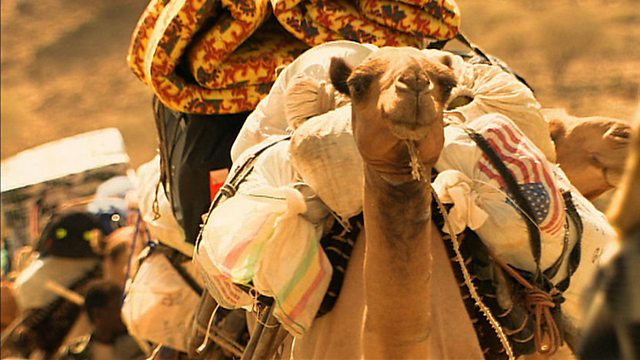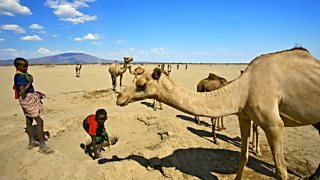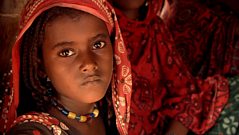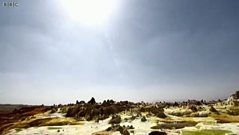
Camel survival
Dromedary camels are the key to the Afar peoples' ability to survive in the Danakil Depression - officially the hottest place on Earth. These hardy animals can survive for days without water and can tolerate temperatures that would kill a human. Steve Leonard does the clever thing and makes friends with one at the first opportunity.
The camel is one of the oldest domesticated animals. People have been using them for over 10,000 years. The males, who can live for 50 years, do all the carrying and can take a load of up to half a ton and still walk 40 kilometres a day. Nothing else on the planet can match this.
Steve Leonard takes the opportunity to study camel biology, using a camel he names Jeff. To cope with the heat, Steve has to drink a litre of water an hour, but Jeff won't drink for the next seven days. Camels don't store water in their humps. Jeff has a little water in his guts, but the key thing is that he doesn't lose the water he's got. He uses his long limbs and long neck as radiators to shed heat without losing water. He hardly sweats at all. He sucks every drop of moisture out of his food and he allows his core body temperature to rise 6 degrees higher than normal, which would kill a human.
Up to 2,000 camels a day travel to the salt mines, and it is so hot that the journey can only be done 6 months of the year. Steve looks at camel droppings, and talks about how the camel can save water by absorbing water in their colon and making dry droppings. Kate and Steve look at the skeleton of a dead camel as Steve wryly comments, this is probably the worst case of dehydration they're likely to see. Scavengers - probably vultures - have eaten almost everything.
Kate Humble investigates how tough life is for an Afar woman; Steve Leonard wants to learn about the relationship between the Afar and their animals, and to help with animal medicine where he can; Dr Mukul Agarwal looks at the health issues faced in this most hostile of environments; earth scientist Dougal Jerram looks at the extraordinary volcanic activity of the region and the part it plays in the bigger geological picture of the Rift Valley; and biologist Richard Wiese searches for extreme life forms in the boiling soil of a massive volcanic fissure.
Duration:
This clip is from
Featured in...
![]()
±«Óãtv Nature
Be captivated, informed and inspired by the world's wildlife.
![]()
Wildlife Highlights 2009
The most fantastic moments from a year of wildlife programming from the ±«Óãtv.
More clips from Episode 1
-
![]()
Birthing fears
Duration: 02:46
-
![]()
Deadly desert
Duration: 00:56
More clips from Hottest Place on Earth
-
![]()
Birthing fears—Episode 1
Duration: 02:46
-
![]()
Deadly desert—Episode 1
Duration: 00:56




